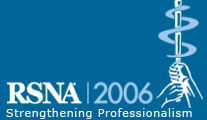
Abstract Archives of the RSNA, 2006
SSG17-03
Navigation System for Interventional CT-guided Procedures: First Phantom and Clinical Experience
Scientific Papers
Presented on November 28, 2006
Presented as part of SSG17: Physics (CT: New Systems)
Martina Meier-Meitinger MD, Abstract Co-Author: Nothing to Disclose
Markus Nagel PhD, Presenter: Nothing to Disclose
Michael Uder, Abstract Co-Author: Nothing to Disclose
Willi A. Kalender PhD, Abstract Co-Author: Consultant, Siemens AG
Founder, VAMP GmbH
Scientific Advisor, VAMP GmbH
Shareholder, VAMP GmbH
Werner A. Bautz MD, Abstract Co-Author: Nothing to Disclose
Ulrich Baum MD, Abstract Co-Author: Nothing to Disclose
Evaluation of practicability and accuracy of a novel navigation system for interventional CT-guided procedures. Investigations in phantom and in patient.
The navigation system (CAPPA IRAD, CAS innovations AG, Erlangen, Germany) was applied in CT-guided biopsies in phantom and patients. The system consists of a PC, navigation software, an optical tracking system and a patient frame. For the phantom study we used a spine phantom in wax. First of all the patient or the phantom is fixed with a double vacuum fixation device (BodyFixTM, Medical Intelligence, Schwab-Munich, Germany) on CT table, the patient frame with optical and CT markers is positioned above and the region of interest is scanned. All data are transferred instantly to the navigation system inside scanning room. The target approach is planned with the navigation software which offers MPRs in four orientations. After this the needle holder is orientated towards the trajectory. Finally a coaxial biopsy needle is pushed to the planned target. The accuracy of the procedures was evaluated using navigation software to measure the distance between target and needle tip.
In the phantom study (n=15) the average deviation between planned and documented needle tip position was 0.9 mm.
In the clinical study (n=15) we performed biopsies of the lung, the mediastinal area, of clavicle and acetabulum, of spine and one nerve root infiltration. In 12 out of 15 cases the needle feed was done in an angulated 3D approach. In 11 cases only one planning and one control scan was carried out before taking biopsy. In spite of an additional safety scan performed in 3 procedures, only once a marginal correction of planned needle feed was done. During the nerve root infiltration three corrections were necessary because of needle bending by using a very thin needle. In all cases the needle tip was within the lesion and histological diagnoses could be defined. The length of procedure was about 30 minutes.
The navigation system allows interventions even of smallest lesions in an angulated approach with a high accuracy.
The navigation system facilitates CT-guided procedures, makes them less traumatic and reduces the radiation exposure.
Meier-Meitinger, M,
Nagel, M,
Uder, M,
Kalender, W,
Bautz, W,
Baum, U,
Navigation System for Interventional CT-guided Procedures: First Phantom and Clinical Experience. Radiological Society of North America 2006 Scientific Assembly and Annual Meeting, November 26 - December 1, 2006 ,Chicago IL.
http://archive.rsna.org/2006/4428758.html

